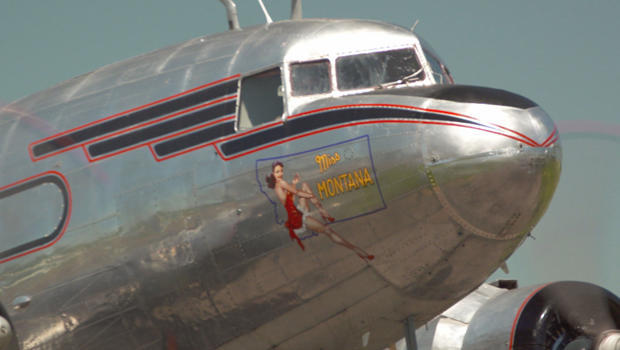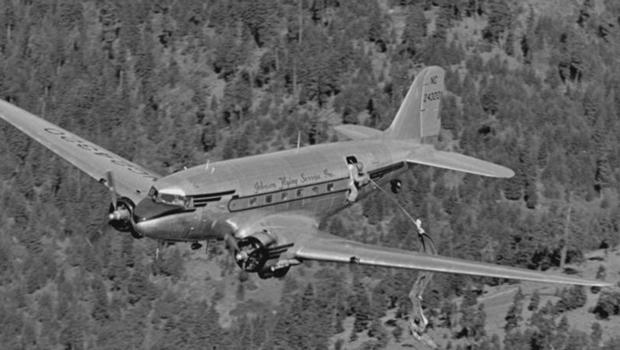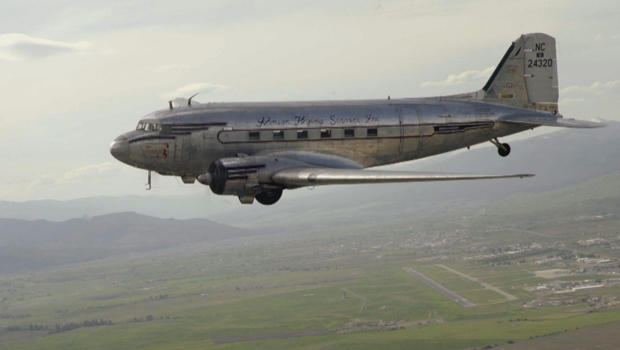“If I’d have known how much work was needed, we might not have started this thing,” pilot Bryan Douglass said.
 <figcaption class="wp-caption-text">“Miss Montana,” a World War II-era C-47 military transport, has been restored to its original glory, in preparation for a flight to Normandy to mark the 75th anniversary of D-Day. (CBS NEWS photo)
<figcaption class="wp-caption-text">“Miss Montana,” a World War II-era C-47 military transport, has been restored to its original glory, in preparation for a flight to Normandy to mark the 75th anniversary of D-Day. (CBS NEWS photo)For Miss Montana, this is a chance for valor that was denied her by timing. She was built in 1944, but by the time she was ready to go into battle, the war ended. “We sort of look at this mission as finishing what she was built for,” he said.
“So, maybe Miss Montana will get a little glory 75 years later?” asked correspondent Richard Schlesinger.
“Maybe,” Douglass replied. “Well, she’ll get glory, yeah!”
If all goes as planned, this plane will join 14 other American C-47s and another group from Europe to retrace the route across the English Channel taken by roughly 850 of these aircraft on D-Day.
“My opinion of the C-47, it’s one of the greatest planes ever built,” said Dan McBride, who was one of the first of thousands of men ferried across the channel that day to parachute into France. He’s 95 now and still remembers D-Day in detail.
“Well, this is something you don’t forget,” he of the invasion of Normandy. He still remembers D-day in detail: “When we flew over the channel, you know, I was standing right in the door looking down 600 feet. And it looked to me like the whole channel was moving. I honestly didn’t believe there was that many ships in the world. And it was the greatest sight I think I’ve ever seen.”
He spent a lot of time in C-47s, but there weren’t many good times.
 <figcaption class="wp-caption-text" id="caption-attachment-166569">Miss Montana’s engines were rebuilt. CBS NEWS photo)
<figcaption class="wp-caption-text" id="caption-attachment-166569">Miss Montana’s engines were rebuilt. CBS NEWS photo)“When they started shooting at us, you know, we wanted to get the hell out of this thing, you know?” McBride laughed. “But yeah, you could hear bullets hitting it. You know, it sounded like rain hitting it. And then the anti-aircraft fire, somebody says, ‘Hey, look at the flares.’ Ain’t no flares!” he laughed.
Jeff Whitesell has heard stories like McBride’s through the years, and they have moved him. That’s part of the reason why he signed on as chief pilot for Miss Montana, knowing she hadn’t flown in close to 20 years.
“It’s really about paying proper tribute,” Whitesell said. “Those folks in World War II are all passing away now. This thing we’re doing in Normandy is probably the last time they’re going to have a proper tribute paid before they’re all gone. So, yeah, there’s a deep-seated mission here for me.”
Accomplishing that mission means defeating the forces of time and circumstance. Shortly after the war, this plane crashed into the Monongahela River in Pittsburgh and sank. After she was raised from the bottom, she flew for years for the Johnson Flying Service, taking firefighters to remote blazes in Montana forests so they could parachute out to extinguish the flames.
 <figcaption class="wp-caption-text">With the war over, Miss Montana would see service as a transport plane for forest firefighters. (CBS NEWS photo)
<figcaption class="wp-caption-text">With the war over, Miss Montana would see service as a transport plane for forest firefighters. (CBS NEWS photo)Over the years, with its history of firefighting, the plane built a following. There was no shortage of volunteers, some dressed in period costume, willing to help get her airborne again.
Crystal Schonemann has been there almost since the beginning, “every weekend for ten months, plus two weeks over Christmas, it’s consuming!” she laughed. “It’s consuming in the best possible way.”
Both engines had to be rebuilt, and there were countless other fixes large and small. Miss Montana fired up the engines and flew again.
One week later, on May 19, she made a triumphant pass over home base, and headed east.
She is traveling in distinguished company, including That’s All Brother – believed to be the first C-47 in the main wave of the D-Day invasion – and Placid Lassie, another D-day veteran who almost ended her days in a Florida weed patch before being brought back to life and flown by Eric Zipkin.
“It saw an enormous amount of action, yeah,” Zipkin said. “It’s extraordinary that I’m able to fly around, not only an airplane like this, but this actual airplane. The rivets that kinda surround me flew over the beaches in Normandy in 1944.”
 <figcaption class="wp-caption-text">Miss Montana takes to the air. (CBS NEWS photo)
<figcaption class="wp-caption-text">Miss Montana takes to the air. (CBS NEWS photo)They will try to do most everything the same way as many of these planes did during the war. They will drop parachutists, just as they did 75 years ago.
Doing it just right is critical for everyone flying this mission, perhaps more so for Al Charters, a parachutist and retired Special Forces officer from Montana whose father was in D-Day.
D-Day: When the Allies turned the tide
Charters said, “if we don’t do it well and we don’t do it accurately, shame on us.”
This is personal for him. The invasion, fierce fighting, and the determination of the allied troops who suffering staggering losses is not just part of world history to him; it’s part of his family’s history.
“It’s a little emotional for you. Tell me why?” asked Schlesinger.
“It’s the same airspace that my father flew in three times on D-Day 75 years ago. So, to share that airspace is perfect.”
This morning Miss Montana is in England – she made it across the Atlantic, along with Placid Lassie and the other airplanes – waiting for the anniversary.
It will be the culmination of that unlikely journey that began more than a year ago.
If all goes well, it will end in honor for the D-Day soldiers, and glory for a vintage airplane that without this mission might never have flown again.
For more info:
- missmontanatonormandy.com
- Museum of Mountain Flying, Missoula, Mont.
- That’s All Brother (Commemorative Air Force, Central Texas Wing)
- Placid Lassie (Tunison Foundation)
- Daks Over Normandy, June 4, 2019

